

Kandice
Seeking to promote peace in the world through singing, listening, playing, and moving to wholesome music.
Untitled. Articles. Scientific explanations. Music in the Classroom. 3 Guidelines to Eliminating Assessment Fog. Consider what it's like to drive through a heavy morning fog.
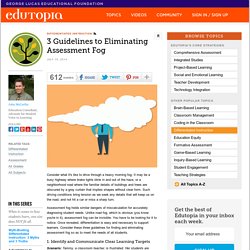
It may be a busy highway where brake lights blink in and out of the haze, or a neighborhood road where the familiar details of buildings and trees are obscured by a gray curtain that implies shapes without clear form. Such driving conditions bring tension as we seek any details that will keep us on the road, and not hit a car or miss a sharp turn. Assessment fog holds similar dangers of miscalculation for accurately diagnosing student needs. Unlike road fog, which is obvious (you know you're in it), assessment fog can be invisible. You have to be looking for it to notice. 1. Scenario: Tammy, a classroom teacher, is frustrated. The heart of quality learning is having clear learning targets. Use the academic criteria list as a filter to align all assessment strategies such as observations and rubrics. 2. Scenario: The sixth grade math teacher reviewed student grades for the semester.
Integrating Drama and Music into the Language Arts Curriculum: It. Letter Sounds Workout. LevensonS. H2948 HW Summit White Paper eVersion. Untitled. Untitled. Index. 8 Ways to Use Music in the Language Arts Classroom. One doesn't need Bach in the background to qualify as having used music.
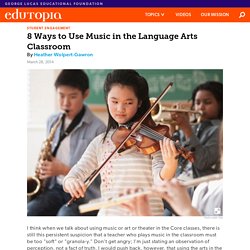
There are many ways to trigger the benefits of music in, say, a Language Arts class, that doesn't require too much knowledge of music in general. Why Use Music? Music can be used to help control a classroom environment or to support the content within that class. It can be used to signal different transitions within the class as well as to serve as a writing prompt itself. Music is also a way to build community and to share yourself as a teacher. The week after I saw The Lego Movie, every period that walked into my middle school classroom was greeted with "Everything is AWESOME! " Reciprocally, I never thought I'd actually appreciate K-pop until my students shared it (sort of in thanks for me turning them onto some Danny Elfman scores).
Music helps create a classroom environment of creativity, but I would also add that it helps make the brain more receptive to deeper critical thinking. The Activities #2 Lyrics as Poetry. Howard Gardner, multiple intelligences and education. Howard Gardner, multiple intelligences and education.
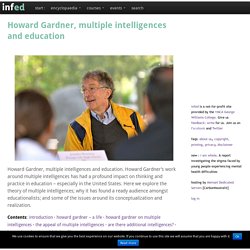
Howard Gardner’s work around multiple intelligences has had a profound impact on thinking and practice in education – especially in the United States. Here we explore the theory of multiple intelligences; why it has found a ready audience amongst educationalists; and some of the issues around its conceptualization and realization. School of Education at Johns Hopkins University-News from the Neurosciences: Recommended Reading.
Brain-Based Learning and Research BibliographySteve Krasner How People Learn: Brain, Mind, Experience, and School Committee on Developments in the Science of Learningby John D.

Bransford, Ann L. Brown, and Rodney R. School of Education at Johns Hopkins University-News from the NeuroSciences; Articles. 12 Brain/Mind Learning Principles in Action – One Author's Personal JourneyRenate CaineEducation professor introduces her twelve organizing principles for how the brain/mind learns and how to use that information to enhance student learning.
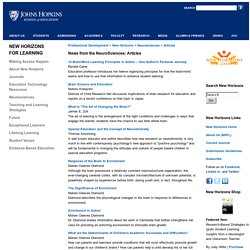
Brain Science and EducationNoboru KobayshiDirector of Child Research Net discusses implications of brain research for education and reports on a recent conference on that topic in Japan. What is "The Art of Changing the Brain? "James E. Susan Kenney. How to Organize Digital Information: Web sites, blogs, and more. “The flood of data on the Web has reached mind-boggling proportions.”

(NPR, 2010) So many websites, blogs, online newsletters … so little time. How can we keep up in the digital world? More importantly, how can we transform information into knowledge? Before information becomes knowledge it’s data, yet another challenge is finding good data when it’s needed. What is Personal Knowledge Management (PKM)? The System to PKM The first and essential component to effective management of digital information is the system itself. Find the right tool or application to manage your digital content. 1) The Tool There are many tools to choose from for managing and sharing digital information, yet the selection of the tool is critical, it can make or break your system.
Pealtrees: I discovered Pearltrees, which is a fluid and intuitive tool that allows me to manage digital information easily. School of Education at Johns Hopkins University-The Art of the Changing Brain. By James E.
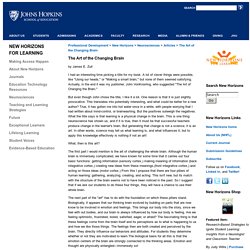
Zull I had an interesting time picking a title for my book. A lot of clever things were possible, like "Using our heads," or "Making a smart brain," but none of them seemed satisfying. Actually, in the end it was my publisher, John VonKnorring, who suggested "The Art of Changing the Brain. " But even though John chose the title, I like it a lot. Johns Hopkins University School of Education Music and Learning: Integrating Music in the Classroom. By Chris Boyd Brewer The following article is reprinted from the book Music and Learning by Chris Brewer, 1995.

This book includes chapters on each method of integrating music in the curriculum. Music suggestions are included.